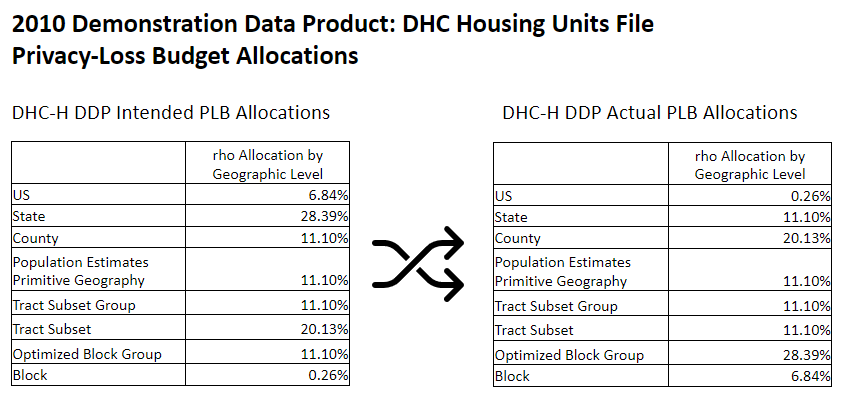Updated 2010 Demonstration Data Metrics Reflect Correction of Inadvertent Coding Error
Updated 2010 Demonstration Data Metrics Reflect Correction of Inadvertent Coding Error
The Census Bureau today released updated detailed summary metrics for the 2010 demonstration data for the Demographic and Housing Characteristics File (DHC) (v. 2022-03-16).
As discussed during the June Committee on National Statistics workshop, we recently discovered an error in a configuration file used to apply privacy-loss budget parameters for the housing units file included in the demonstration data product. This configuration error inadvertently reversed the order of privacy-loss budget (PLB) allocations by geographic level (see image below). The persons file included in the demonstration data product was unaffected by the error.

We have corrected the code and those updates will be reflected in the second round of demonstration data slated for release in August. We have also updated the PLB allocation fact sheet for the March release, showing both the intended allocations and the actual allocations used. The August release will reflect significant updates to the disclosure avoidance system’s (DAS) parameters, driven by data user feedback and our own extensive analysis. Your submitted use cases were instrumental in helping set the accuracy targets against which we are tuning the DAS’s parameters.
Since the PLB allocation error resulted in unintended shifts in the accuracy in the data, the corrections will cause shifts, as well.
The Census Bureau makes this commitment: in both the second demonstration data product and the final production run, the Census Bureau will maintain or improve the level of accuracy for the vast majority of tabulations above the block level that were released with greater accuracy than intended in the March demonstration data product, provided that this level of accuracy can be supported without undermining the overall confidentiality protections. Our ongoing confidentiality protection assessments will be important because disclosure risks are highest for data published for very small geographies (especially for data published at the block level).
General Impact of the Allocation Error
In general, and as reflected in the updated metrics, the unintended allocations in the March demonstration data for the housing unit file had the following impact:
- U.S. and state-level tabulations in the demonstration product were significantly less accurate than intended.
- County-level tabulations in the demonstration product were slightly more accurate than intended.
- Tabulations for incorporated places in the demonstration product were comparable.
- Tract-level tabulations in the demonstration product were slightly less accurate than intended.
Again, the Census Bureau will ensure that accuracy levels above the block level in the upcoming data products meet or exceed the levels in the March demonstration data, consistent with ongoing confidentiality assessments.
Per Procedure, an Independent External Code Review Will Precede Final Release
Although the algorithm behind the disclosure protections undergoes a thorough and independent external code review before going into final production, it doesn’t go through the same level of review during development. Development involves multiple rapid-cycle code changes and experimental tuning runs to find the combination of settings that meet accuracy and confidentiality needs.
Once the final settings are selected, we allot significant time in the production schedule for the independent external code peer review, as we did for the production code in the 2020 Census Redistricting Data (P.L. 94-171) Summary File release. That review is designed to identify any coding errors introduced during development.
Missed the CNSTAT Workshop? Slides and Video Now Online
Slides and video presentations from the June CNSTAT Workshop are now posted on the CNSTAT website. The workshop featured multiple analyses by data users of the March 16, 2022, DHC demonstration data.
As always, please contact us via [email protected] if you have any questions.



